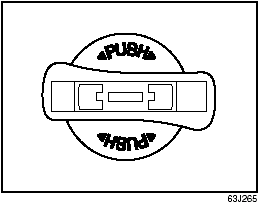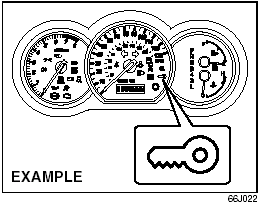Starting the Engine
Before Starting the Engine
1) Make sure the parking brake is set fully.
2) Manual Transmission – Shift into “N” (Neutral) and depress the clutch pedal all the way to the floor.
Hold it while starting the engine.
Automatic Transmission – If the gearshift lever is not in “P” (Park) position, shift into “P”. (If you need to re-start the engine while the vehicle is moving, shift into “N”.)
NOTE:
The engine of manual transmission vehicle
will not start unless the clutch pedal is
depressed.
NOTE:
Automatic transmission vehicles have a
starter interlock device which is designed
to keep the starter from operating if the
transmission is in any of the drive positions.
 WARNING:
WARNING:
Make sure that the parking brake is
set fully and the transmission is in
Neutral (or Park for vehicles with an
automatic transmission) before
attempting to start the engine.
Starting a Cold Engine
With your foot off the accelerator pedal, crank the engine by turning the ignition key to “START”. Release the key when the engine starts.
CAUTION:
• Stop turning the starter immediately
after the engine has started or
the starter system can be damaged.
• Do not crank the engine for more than 15 seconds at a time. If the engine doesn’t start on the first try, wait about 15 seconds before trying again.
If the engine does not start after 15 seconds of cranking, wait about 15 seconds, then press down the accelerator pedal to 1/3 of its travel and try cranking the engine again. Release the key and accelerator pedal when the engine starts.
If the engine still does not start, try holding the accelerator pedal all the way to the floor while cranking. This should clear the engine if it is flooded.
If you are unable to start the engine using this procedure, consult your SUZUKI dealer.
Starting a Warm Engine
Use the same procedure as for “Starting a Cold Engine”.

Vehicle With Keyless Start System
The ignition switch can be operated when the remote controller is in the vehicle except the rear luggage area. To turn the ignition switch, push the switch first.
NOTE:
You must push in the ignition switch to turn
it from the “LOCK” position to the “ACC”
position. To return to the “LOCK” position
from the “ACC” position, turn the ignition
switch counterclockwise while pushing in
the switch.

If the keyless start system blue indicator light illuminates on the instrument cluster, you can turn the ignition switch. If the red indicator light illuminates, you can not turn the ignition switch.
NOTE:
• The ignition switch can be turned to the
“ACC” position when the keyless start
system blue indicator light illuminates.
The blue indicator light will illuminate for several seconds and then turn off to protect the system. In this case, you must release the ignition switch once and push the switch again.
• If the keyless start system red indicator light illuminates, the remote controller may not be in the vehicle or the battery of the remote controller may be unreliable.
When the remote controller is in the vehicle except the rear luggage area, you can turn the ignition switch without using an ignition key.
NOTE:
• If the battery of the remote controller
runs down or there are strong radio
waves or noise, the operating range may
be narrower or the remote controller may
be inoperative.
• If the remote controller is too close to the door glass, it may not operate.
• The ignition switch may not turn when the remote controller is on the instrument panel, in the glove box, in the door pocket, in the sun visor or on the floor.
CAUTION:
The remote controller is a sensitive
electronic instrument. To avoid damaging
it, do not expose it to impacts,
moisture or high temperature (such
as on the dashboard under direct
sunlight).
You can also turn the ignition switch by inserting the ignition key into the slot.
See also:
Temperature Gauge
Temperature Gauge
When the ignition switch is in the “ON”
position, this gauge indicates the engine
coolant temperature. Under normal driving
conditions, the indicator should stay within
th ...
Speedometer/Odometer/Tripmeter/Brightness Control
Speedometer/Odometer/Tripmeter/Brightness Control
(1) Speedometer.
(2) Odometer/Tripmeter.
(3) Odometer/Tripmeter selector, Brightness control knob.
Speedometer
The speedometer indicates vehicl ...
Tires
For safe operation of your vehicle, it is
important that the tires be the correct type
and size, in good condition, and properly
inflated. Be sure to follow the requirements
and recommendations in ...
